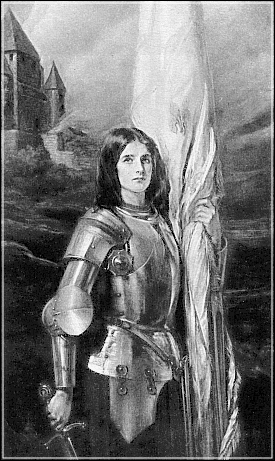
Joan of Arc was not a crusader for women’s rights or suffrage, those ideals had no standing in her day, but a warrior, fighting for her country by breaking gender roles of the time. 15th century France France
Joan of Arc, born in 1412, had seen the effects of the war from a young age when her village was attacked and burned by opposing forces. At the age of 12, Joan heard her first voices. Throughout her life, Saints came to Joan relying messages from God. Although she would have been happy staying home and taking care of her mother, Joan was instructed by these voices to drive the English out of France
At the court she stated her mission and made a specific military prediction to try and prove divine nature of her quest. When the prediction came true, Joan, a teenage girl with no military training was sent off to Orlèans, the site of an important military siege. She encountered resistance and exclusion from the officers, but her strong religious center raised the moral of the troops, gaining her support and standing. Once a respected officer, Joan of Arc began to make decisions and strategies about the war. She was persistent and defiant in her goal to change the war strategy from defensive into offensive attacks. This new strategy led to a large number of successes for the French army and gained Joan the position of co-commander of the army.
Her successes continued until 1430, when she was captured by the Burgundians. The English government purchased her from the Burgundians shortly after. Joan was a military threat to the English, an enemy of the state and the church. Although she was a religious and pious woman who believed she was instructed by God, she was tried for heresy for, among other things, wearing men’s clothing, a violation of a biblical law., Joan wore men’s clothing for convenience and protection in battle, and protecting herself from sexual assault, which she encountered during her imprisonment, which are actually situations where cross-dressing is accepted by the bible, although this was not recognized by the court.
Throughout the trial, Joan was true to her convictions, unwilling to denounce her role in the military or her clothing attire. She risked her life on the battlefield, and in the courtroom, but in the end it was the law that got her. The court found her guilty, and on May 30th 1431, when she was only 19 years old, Joan of Arc was executed, burned on the stake. This ruling was overturned 24 years later by the Pope, making Joan of Arc a martyr. Five hundred years later, in 1920 Joan of Arc was canonized and became a patron saint of France
Joan of Arc needs to be remembered as a great example of girl power. She embodied the potential all women have to succeed in a male dominated society if she believes in herself. She believed in her cause, her ability and had faith she was doing the right thing. She was independent in a time when a woman’s status and livelihood depended on men, and became a national hero by defying expectations. The strict gender roles of the time meant nothing to this maiden on a mission.
No comments:
Post a Comment